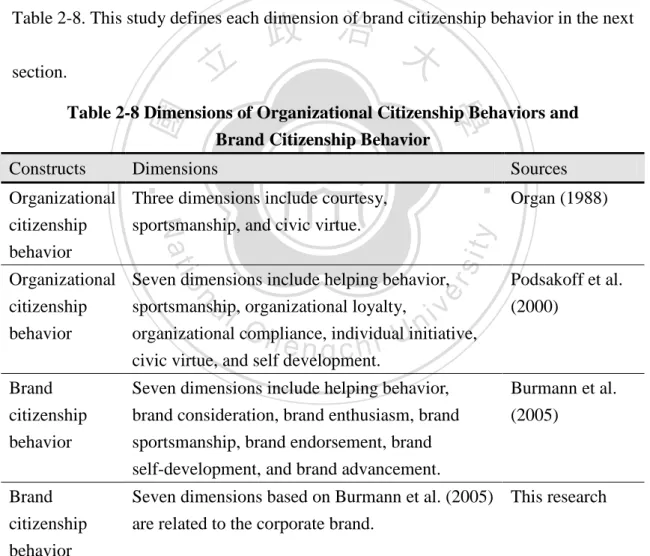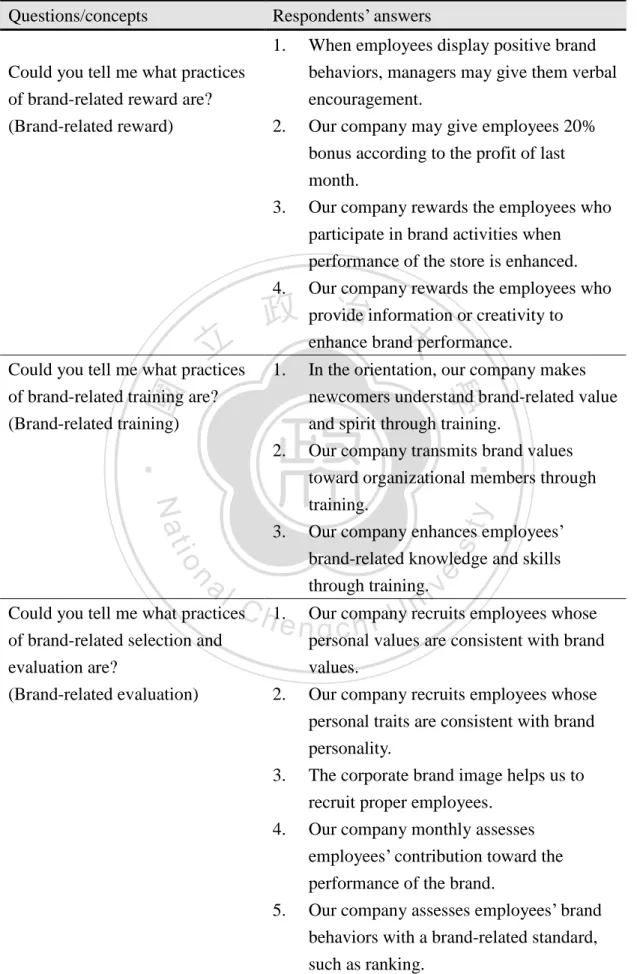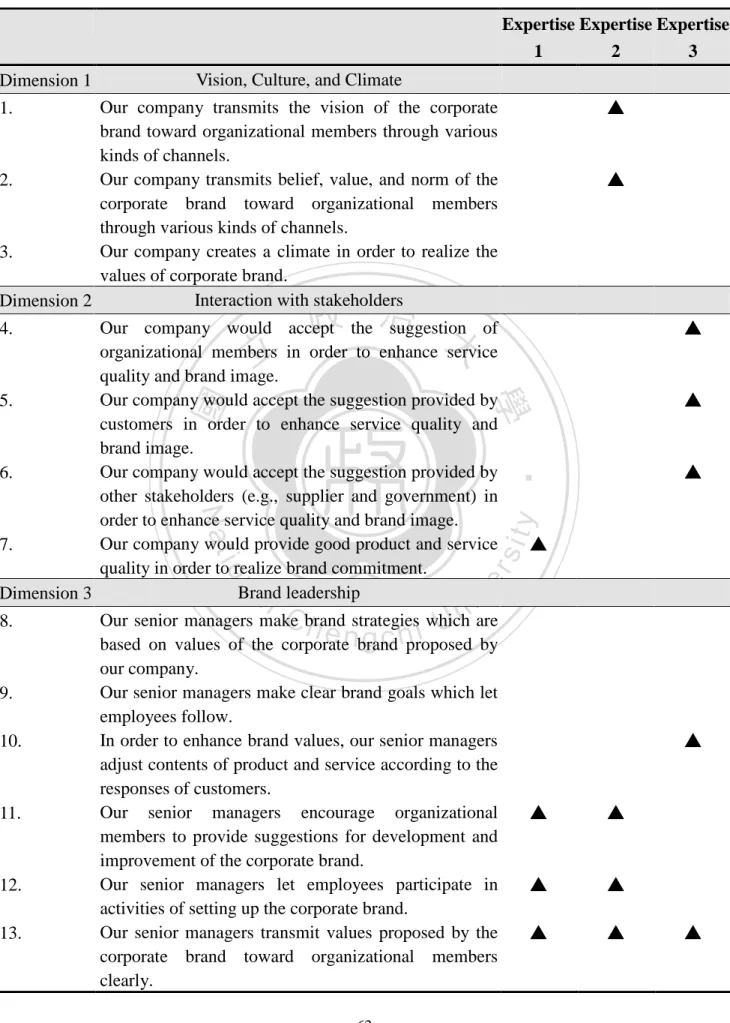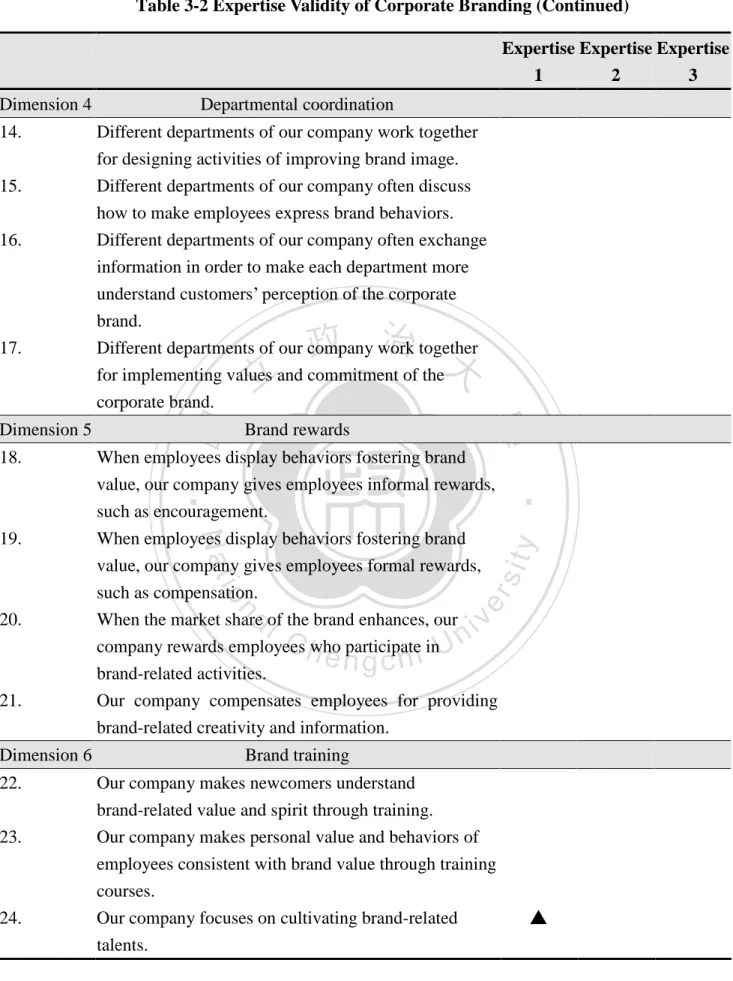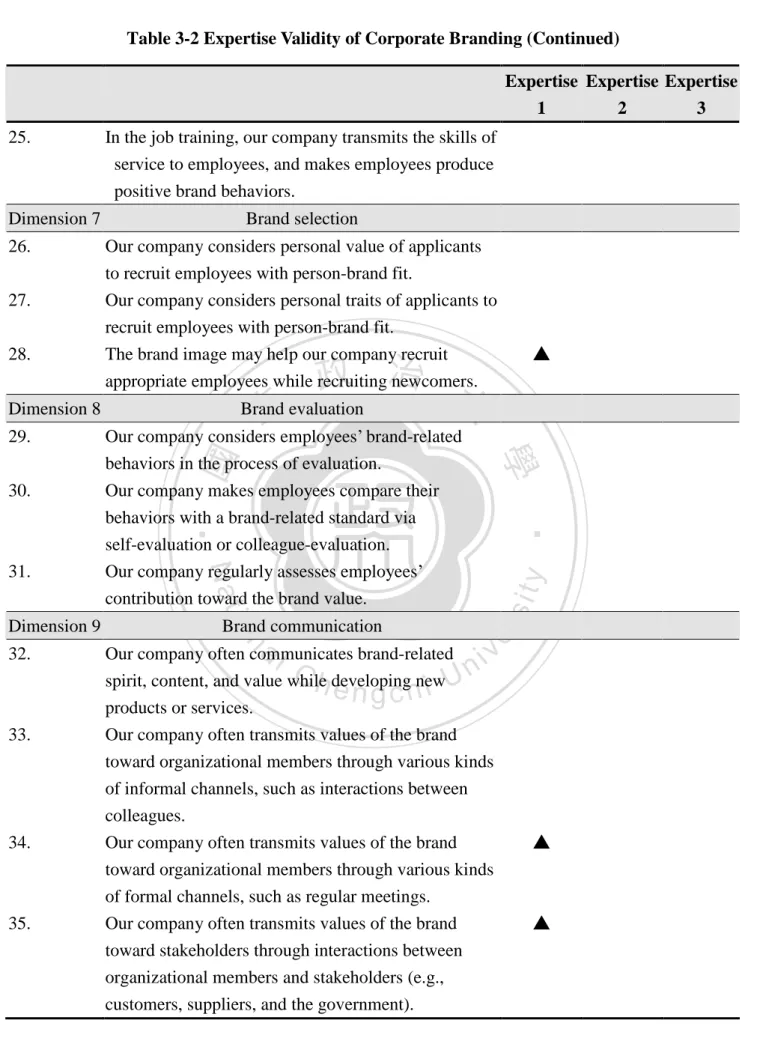品牌心理擁有感之前因與結果因素之研究:量表發展與多層次之研究方法 - 政大學術集成
全文
(2) Contents Abstract………………………………………………………………………………1 Chapter 1 Introduction……………………………………………………………...3 1.1 Background and Research Motives……………….……………………………..3 1.2 Research Objectives and Questions…………………………………………….13 1.3 Research Process………………………………………………………………..15 1.4 Expected Contribution…………………………………………………………..16 1.5 Dissertation Organization……………………………………………………….17 Chapter 2 Literature Review……………………………………………………….18 2.1 Corporate Branding……………………………………………………………..18 2.2 Corporate Brand………………………………………………………………...19. 政 治 大 2.3 Key Concepts of Corporate Branding…………………………………….…….22 立 2.4 The Dimensions of Corporate Branding………………………………………..25 ‧. ‧ 國. 學. 2.5 The Definition of Brand Psychological Ownership…………….………….33 2.6 Key Concepts of Organizational Psychological Ownership and Brand Psychological Ownership……………………………………………………….34 2.7 Brand Psychological Ownership, Brand Commitment, and Organizational Commitment……………………………………………………………….……38 2.8 Dimensions of Psychological Ownership and Brand Psychological Ownership.40 2.9 The Definitions of Dimensions of Brand Psychological Ownership…………...41 2.10 Brand Psychological Ownership in Diversified Branding Strategies……...….44 2.11 The Definition of Brand Citizenship Behavior………………………..………45 2.12 The Concepts and Dimensions of Brand Citizenship Behavior……………..46 2.13 The Definitions of Dimensions of Brand Citizenship Behavior…………….49 2.14 Brand Citizenship Behavior in Diversified Branding Strategies……...….52 2.15 Summary……………………………………………………………………...54. n. er. io. sit. y. Nat. al. Ch. engchi. i Un. v. Chapter 3 Scale Development……………………..…………………………55 3.1 Organization-level Variable: Corporate Branding………………..……………55 3.2 Individual-level Variables: Brand Psychological Ownership and Brand Citizenship Behavior...………………………………………………………….77 3.3 Further Examination of Validity………………………………………..……106 Chapter 4 Hypotheses Deve lopment and Research Framework ………………..121 4.1 The Antecedent and Consequence of Brand Psychological Ownership……….122 I.
(3) 4.2 Social Identity Theory, Social Exchange Theory and Corporate Branding…...125 4.3 Hypotheses…………………………………………………………………….127 Chapter 5 Research Methodology and Analytical Results……………………145 5.1 Procedures Used to Justify Aggregation………………………………...…….145 5.2 Aggregation of the Constructs………………………………………………....146 5.3 Descriptive Statistics of Multilevel Data……………………………..….…….148 5.4 Sample Procedures……………………………………………….……...…….149 5.5 Measurement……………………………………..…………………………....150 5.6 Common Method Variance…………………………………………..….…….152 5.7 Results of Research Model…………………………………………..….…….154 5.8 Detailed Analyses of Research Model………………..……………..….…….163. 政 治 大. Chapter 6 Conclusion and Suggestion.…………………………………………172 6.1 Discussions of Hypotheses..………………………………………………….172 6.2 Implications and Suggestion…………………………………………………178 6.3 Contributions, Limitations and Future Study………………………………….187. 立. ‧ 國. 學. ‧. Reference…………………..………………………………………………………192. n. al. er. io. sit. y. Nat. Appendix…………………. . ………………………………………. . ……..………208 Table 1 Organization-level Questionnaires………....…………..…………………208 Table 2 Individual-level Questionnaires-BPO….......…………..…………………210 Table 3 Individual-level Questionnaires-BCB….......…………..…………………211 Table 4 Questionnaires of Brand Equity………………………..….……………212 Table 5 Franchise Organizations That Accept Surveys…………………………213 Table 6 Participants of In-depth Interviews of Corporate Branding………………214 Table 7 Participants of In-depth Interviews of BPO and BCB……….……………215 Table 8 Multilevel Data Collection Procedure ……………………..……………216 Chinese Questionnaire of Corporate Branding……….………..…………….……217 Chinese Questionnaire of BPO and BCB……….…………………..……….……221 Chinese Questionnaire of Brand Equity………………………….………………227. Ch. engchi. II. i Un. v.
(4) Figures Figure 1-1 Research Process………………………………………………………....16 Figure 2-1 The Relationship between the Two Constructs: Brand citizenship Behavior and Organizational Citizenship Behavior...................................................53 Figure 3-1: Measure Model of Corporate Branding…………………………………74 Figure 3-2: Secondary CFA of Corporate Branding…………………………………75 Figure 3-3: Measurement Model of Brand Psychological Ownership………………98 Figure 3-4: Secondary CFA of Brand Psychological Ownership……………………99 Figure 3-5: Measurement Model of Brand Citizenship Behavior...……………….101 Figure 3-6: Secondary CFA of Brand Citizenship Behavior...…………………….102 Figure 3-7 Measurement Model of BPO and BCB……………………………….107 Figure 3-8 Measurement Model of BPO, OPO and OC…………………………...112 Figure 3-9 Measurement Model of BPO, BCB and OCB………………………….116. 政 治 大 Figure 4-1 Research Framework……………………………………………………143 立 ‧. ‧ 國. 學. n. er. io. sit. y. Nat. al. Ch. engchi. III. i Un. v.
(5) Tables Table 2-1 A Comparison between Corporate and Product Brands…………………..20 Table 2-2 Key Concepts of Corporate Brand, Corporate Identity, Corporate Image, and Corporate Reputation…………………………………………………22 Table 2-3 Key Concepts of Corporate Branding…………………………………….23 Table 2-4 Dimensions of Corporate Branding……………………………………….26 Table 2-5 Comparison between Organizational Psychological Ownership and Brand Psychological Ownership…………………………………………..37 Table 2-6 Key Concepts of Brand Psychological Ownership, Brand Commitment and Organizational Commitment………………………………………………38 Table 2-7 Dimensions of Psychological Ownership and Brand Psychological Ownership.………………………………………………………..……..41 Table 2-8 Dimensions of Organizational Citizenship Behaviors and Brand Citizenship. 政 治 大 Behavior..……………………….…………………………………………49 立 Table 3-1 Key Concepts of Corporate Branding Obtained from In-depth Interviews.57 ‧. ‧ 國. 學. Table 3-2 Expertise Validity of Corporate Branding…………………………………62 Table 3-3 EFA of Corporate Branding (Varimax Rotation)…………………………..67 Table 3-4 Items of Communication and Evaluation of Corporate Branding………...69 Table 3-5 Items of Departmental Coordination of Corporate Branding……………..70 Table 3-6 Leadership and Interaction with Stakeholders of Corporate Branding……71 Table 3-7 Items of Training and Selection of Corporate Branding………………….72 Table 3-8 Items of Vision and Culture of Corporate Branding………………………73 Table 3-9 CFA of Corporate Branding……………………………………………….73 Table 3-10 PHI, SE, and T in Measure Model of Corporate Branding………………76 Table 3-11 Standardized λand T in Measure Model of Corporate Branding………..77 Table 3-12 Key Concepts of Brand Psychological Ownership Obtained from In-depth Interviews………………………………………………………80 Table 3-13 Key Concepts of Brand Citizenship Behavior Obtained from In-depth Interviews………………………………………………………82 Table 3-14 Expertise Validity of Brand Psychological Ownership………………….84 Table 3-15 Expertise Validity of Brand Citizenship Behavior……………………..86 Table 3-16 EFA of Brand Psychological Ownership (Varimax Rotation)…………..90 Table 3-17 EFA of Brand Citizenship Behavior (Varimax Rotation)………………91 Table 3-18 Items of Identification and Belongingness of Brand……………………93 Table 3-19 Items of Brand Self-efficacy…………………………………………….93 Table 3-20 Items of Brand Accountability…………………………………………94 Table 3-21 Items of Sportsmanship and Endorsement of Brand…………………….95. n. er. io. sit. y. Nat. al. Ch. engchi. IV. i Un. v.
(6) Table 3-22 Items of Helping Behaviors of Brand……………………………………95 Table 3-23 Items of Consideration and Enhancement of Brand……………………..96 Table 3-24 CFA of Brand Psychological Ownership………………………………...98 Table 3-25 Fitness indices of Brand Citizenship Behavior...………………………101 Table 3-26 PHI, SE, and T in Measurement Model of Brand Psychological Ownership................................................................................................103 Table 3-27 Standardized λand T in Measurement Model of Brand Psychological Ownership................................................................................................104 Table 3-28 PHI, SE, and T in Measurement Model of Brand Citizenship Behavior.105 Table 3-29 Standardized λand T in Measurement Model of Brand Citizenship Behavior...................................................................................................105 Table 3-30 Fitness indices of Brand Citizenship Behavior………………………108 Table 3-31 PHI, SE, and T in Measurement Model of BPO and BCB……………..108 Table 3-32 Standardized λand T in Measurement Model of BPO and BCB……….109. 政 治 大 Table 3-33 Items of Organizational Psychological Ownership……………………..111 立 Table 3-34 Items of Organizational Commitment…………………………………..111 ‧. ‧ 國. 學. Table 3-35 PHI, SE, and T of Measurement Model of BPO, OPO and OC………..113 Table 3-36 Standardized λand T of Measurement Model of BPO, OPO and OC….113 Table 3-37 Items of Organizational Citizenship Behavior..………………..……….115 Table 3-38 PHI, SE, and T in Measurement Model of BPO, BCB and OCB………117 Table 3-39 Standardized λand T in Measurement Model of BPO, BCB and OCB..117 Table 5-1 Procedures Used to Justify Aggregation…………………………………146. sit. y. Nat. n. al. er. io. Table 5-2 Values of rwg………………………………………………………...……148 Table 5-3 Values of ICC (1) and ICC (2) …………………………..………...……148 Table 5-4 Data Utilized in Multilevel Analyses……………………………………149 Table 5-5 Fitness indices of Different Models……………………………..………154 Table 5-6 Means, Standard Deviation, and Correlations of Research Constructs…155 Table 5-7 Null Model………………………………………………………………157 Table 5-8 Hierarchical Linear Modeling Results of the Proposed Model…………161 Table 5-9 Hierarchical Linear Modeling Results: Brand PO on Band CB (Detailed Analyses)……………………………………………………………….165 Table 5-10 Hierarchical linear modeling results of the proposed model (Detailed Analyses)………………………………………………………………168. Ch. engchi. V. i Un. v.
(7) A Study of the Antecedent and Consequence of Brand Psychological Ownership: Scale Development and Multilevel Approaches Abstract This thesis aims to investigate the antecedent and consequence of brand psychological ownership. Three major constructs related to branding efforts and results studied and explored by this research include corporate branding, brand psychological ownership, and brand citizenship behavior. The first construct,. 政 治 大. corporate branding, represents practices that improve brand cognitions and brand. 立. attitude of multiple stakeholders. The second construct, brand psychological. ‧ 國. 學. ownership, represents the psychological state that makes employees produce feeling of ownership toward the corporate brand. The third construct, brand citizenship. ‧. behavior, shows that employees have brand-oriented altruistic spirit and live the brand.. Nat. sit. y. In order to explore the antecedent and consequence of brand psychological ownership,. al. er. io. two major steps are conducted by this study. First, this study conducts the scale. iv n C thishstudy the multilevel e n gexplores chi U. n. developments of corporate branding, brand psychological ownership, and brand citizenship behavior. Second,. relation between. corporate branding, brand psychological ownership, brand citizenship behavior, and brand equity. The guidelines of Hinkin (1998) are followed as the procedures of scale development. As for the scale development of corporate branding, a survey conducted among a sample of 275 managers from the franchise organizations in Taiwan was undertaken. Five factors of corporate branding obtained after EFA and CFA include: communication and evaluation of corporate branding, departmental coordination of corporate branding, leadership and interaction with stakeholders of corporate branding, training and selection of corporate branding, and vision and culture of. 1.
(8) corporate branding. The results represent a scale of corporate branding with good reliability and validity. As for scale developments of brand psychological ownership and brand citizenship behavior, a survey conducted among a sample of 361 customer-facing employees from the franchise organizations in Taiwan was undertaken. Three factors of brand psychological ownership obtained after EFA and CFA include: brand self-efficacy, brand accountability and identification and belongingness of brand. Three factors of brand citizenship behavior obtained after EFA and CFA include: sportsmanship and endorsement of brand, helping behavior of brand, and. 政 治 大 psychological ownership and brand citizenship behavior with good reliability and 立 consideration and enhancement of brand. The results represent scales of brand. ‧ 國. 學. validity.. In the individual level analyses, brand psychological ownership has a positive. ‧. effect on brand citizenship behavior, and most factors of brand psychological. sit. y. Nat. ownership have positive effects on factors of brand citizenship behavior. In the. psychological. al. n. brand. io. on. ownership. Ch. and. er. multilevel analyses, results demonstrate that corporate branding has positive effects brand. n engchi U. iv. citizenship. behavior.. Organizational-level brand citizenship behavior positively affects brand equity. It is also found that brand psychological ownership fully mediates the relationship between corporate branding and brand citizenship behavior. Detailed analyses show that many factors of corporate branding have positive effects on different factors of brand psychological ownership and brand citizenship behavior. Most factors of brand psychological ownership positively affect factors of brand citizenship behavior. Discussion, contributions, implication, limitation, and future study are also discussed.. Key words: corporate branding, brand psychological ownership, brand citizenship behavior, scale development, and multilevel analyses. 2.
(9) Chapter 1 Introduction 1.1 Background and Research Motives Compared to extensively studied topics related to brand management (e.g., perception, associations, and extension), brand psychological ownership is a new construct that recently attracts the attention of practitioners and academics. Brand psychological ownership is extended from perspectives of organization psychological. 政 治 大. ownership. Pierce, Kostova, and Dirks (2001) assert that psychological ownership is. 立. regarded as the feeling of possessiveness making organizational members. ‧ 國. 學. psychologically tied to tangible and intangible objectives. Van Dyne and Pierce (2004). ‧. argue that psychological ownership is the psychologically experienced phenomenon. y. Nat. Luthans (2009) assert that. al. er. and. io. Crossley,. sit. that makes employees produce possessive feelings toward the target. Avey, Avolio, psychological ownership is a. n. iv n C h easnthe cognitive-affective construct defined h i inUwhich organizational members g cstate. feel the targets as theirs and reflect their awareness, thoughts, and beliefs concerning the target. Extended from above-mentioned perspectives, brand psychological ownership is regarded as the psychologically experienced state in which organizational members feel they are psychologically tied to the brand of the organization. Organizational members feel the brand as their own brand, and reflect their awareness, thoughts, and beliefs regarding the brand.. 3.
(10) Brand psychological ownership is especially significant in the franchise organization, because the brand image, organizational reputation, and corporate name, which can be enhanced by practices of corporate branding (Souiden, Kassim and Hong, 2006), are important assets in the franchise organization. Based on Burmann and Zeplin (2005), employees’cognition (i.e., brand commitment) can be improved by branding practices, such as brand leadership, brand communication, and. 政 治 大. brand-centered HRM. Similarly, a franchisee organization may adopt practices of. 立. corporate branding (i.e., brand-centered HRM, brand leadership and brand. ‧ 國. 學. communication) to make organizational members have feelings of brand. ‧. psychological ownership, thus contributing to brand image, organizational reputation,. y. Nat. er. io. sit. and corporate name. For example, McDonald and Wang Steak adopt some practices of corporate branding (e.g., brand training and brand communication) to make. al. n. iv n C U h e n gwith employees feel they are closely connected brand and then produce c hthei corporate. good service attitudes and behaviors, thus contributing to the brand image of Wang Steak. However, few researches have explored the construct of brand psychological ownership; there exists a large gap to improve in the field of brand psychological ownership. Organizational members who have psychological ownership produce the feeling of “ I ti sMI NE! ”towards tangible and intangible objects (Pierce, Rubenfeld, and Morgan 1991). That is, employees with brand psychological ownership have the. 4.
(11) feeling of “ I ti sMI NE! ”toward tangible objects (e.g., product) and intangible objects (e.g., corporate brand). Van Dyne et al. (2004) argued that employees with organizational psychological ownership have three traits which include positive attitudes, self-concept, and sense of responsibility toward the target, all of which contribute to organizational citizenship behavior. Building on the argument, brand psychological ownership can make employees produce positive brand attitudes and. 政 治 大. behavior. From practical phenomenon of Wang Steak, employees who have brand. 立. psychological ownership produce feelings of ownership toward the corporate brand. ‧ 國. 學. and feel effective in brand-related activities. For example, employees can participate. ‧. in brand-related decision-making in “ Awa ki ng Li on Pr og r a m” . However, the. y. Nat. er. io. sit. formation of brand psychological ownership has not yet been explored. Thus, the first motive of this research is to explore the key concepts and contents of brand. n. al. psychological ownership.. Ch. engchi. i Un. v. Psychological ownership is profoundly related to altruistic spirit that contributes to organizational citizenship behaviors. Van Dyne et al. (2004) found that organizational psychological ownership is positively associated with organizational commitment, which further contributes to organizational citizenship behavior (Podsakoff, MacKenzie, Paine and Bachrach, 2000). The factors that foster psychological ownership may be attributed to organizational support. As. 5.
(12) demonstrated by Allen, Shore, and Griffeth (2003), organizational commitment is positively affected by perceived organizational support; employees who perceive organizational support may be encouraged to produce positive attitudes to reciprocate organizations (Blau, 1986), thus producing altruistic spirit which contributes to organizational citizenship behaviors. In addition, the organizational support (e.g., corporate branding) could evoke the feeling of psychological ownership as contended. 政 治 大. in the preceding paragraph. Extended from above-mentioned perspectives, this study. 立. argues that brand psychological ownership is positively associated with brand. ‧ 國. 學. altruistic spirit that contributes to brand citizenship behavior. In the context of. ‧. franchise organizations, employees who have psychological feelings of being closely. y. Nat. er. io. sit. connected with the corporate brand may produce brand psychological ownership that contributes to brand citizenship behavior. Similarly, Burmann et al. (2005) proposed. al. n. iv n C U which contributes to brand that brand commitment can arousehbrand e n galtruistic c h i spirit. citizenship behavior, yet, they did not further investigate the relationship between brand psychological ownership and brand citizenship behavior. This study argues that brand psychological ownership which can make employees produce brand altruistic spirit that contributes to brand citizenship behavior. Based on practical phenomenon of Burger King, employees with brand psychological ownership identify the corporate brand and feel effective in brand-related activities, contributing to employees’service. 6.
(13) behavior. However, researchers have not yet investigated why brand psychological ownership contributes to brand citizenship behavior. Therefore, the second motive of this research is to explore the relationship between brand psychological ownership and brand citizenship behavior. In response to the dynamic environment, organizations have to make strategies adapted to the environment and then enhance their competitive capability; therefore,. 政 治 大. an organization may adopt the strategy of differentiated position related to the. 立. organizational symbolized values such as corporate brands (Hatch and Schulz, 2003).. ‧ 國. 學. Several scholars proposed the concept of corporate branding to describe the branding. ‧. efforts especially focused on corporate brands instead of building product brands.. y. Nat. er. io. sit. According to Harris and de Chernatony (2001), corporate branding concerns the coordination of internal and external resources to contribute to a coherent brand. al. n. iv n C U held by multiple stakeholders h e nperceived reputation, and a favorable brand identity g c h i and. such as employees, customers, and managers. Employees as key stakeholders who provide the interface between internal identity and external expression may be expected to interact with other stakeholders (e.g., customers), and then enhance the corporate brand values (Brexendorf and Kernstock, 2007). As argued by Hatch et al. (2003), an organization may communicate values, beliefs, basic assumptions of the corporate brand to organizational members through corporate branding, and make. 7.
(14) organizational members have congruent cognitions which contribute to the success of corporate branding (Harris et al., 2001). Furthermore, Burmann et al. (2005) assert that the three levers including brand-centered HRM, brand communication, and brand leadership can affect employees’brand-related cognitions (e.g., brand commitment) which imply that practices of corporate branding can be considered as the antecedents of brand psychological ownership. Apparently, employees’passion for the corporate. 政 治 大. brand is the success of corporate branding efforts; those branding efforts like building. 立. corporate brand and empowerment of employees shall be important. According to the. ‧ 國. 學. practical phenomenon of 7-Eleven, practices of corporate branding (e.g.,. ‧. brand-centered HRM) affect employees’cognitions and make employees feel. y. Nat. er. io. sit. responsible for brand-related activities. However, researchers have not yet investigated why practices of corporate branding can affect brand psychological. al. n. iv n C ownership. Thus, the third motive h ofe this n research g c h i isUto explore relationship between practices of corporate branding and brand psychological ownership. As argued by Hatch et al. (2003), an organization can transmit vision, belief, value, and norm of brand toward employees in the process of corporate branding, and then make employees’behaviors transformed. Brand citizenship behavior is considered not only as one part of organizational citizenship behavior, but also the externally targeted behavior which contributes to perceptions of external stakeholders. 8.
(15) (Burmann et al., 2005). The practices of corporate branding (e.g., brand-centered leadership) may foster followers’perception of variety and autonomy and then make employees produce positive behavior (e.g., brand citizenship behavior) (Piccolo and Coiquitt, 2006). From empirical evidence, transformational leadership is positively associated with organizational citizenship behavior (Podsakoff, MacKenzie, Moorman and Fetter, 1990). Both transformational leadership and brand-oriented. 政 治 大. leadership are considered as effective leadership (Burmann et al., 2005). According to. 立. above-mentioned perspectives, this study argues that practices of corporate branding. ‧ 國. 學. positively affect brand citizenship behavior. From practical phenomenon of 7-Eleven,. ‧. practices of corporate branding (e.g., brand communication) make employees produce. y. Nat. er. io. sit. positive behavior, such as following brand guidelines before actions. However, few researches have investigated why practices of corporate branding affect brand. al. n. iv n C citizenship behavior. Therefore, thehfourth this research is to investigate the e n gmotive c h iof U relationship between corporate branding and brand citizenship behavior. Based on prior research, practices of corporate branding (e.g., brand-centered HRM) can make employees be a good organizational agent, thus contributing to perceptions of customers. Supportive HRM may contribute to the employee’ s role of a good organizational agent that enhances customers’perceptions (Sun, Aryee, and Law, 2007). Brand citizenship behavior is regarded as not only employees’voluntary. 9.
(16) behavior that contributes to internal stakeholders but also service-oriented behaviors that improve brand equity (Burmann et al., 2005). Based on practical phenomenon of Wang Steak, customer-facing employees who have brand citizenship behavior (e.g., helping behaviors of corporate brand) can improve customers’perceptions toward the corporate brand. However, researchers have not yet investigated why brand citizenship behavior contributes to brand equity. The fifth motive of this research is to. 政 治 大. explore the relationship between brand citizenship behavior and brand equity.. 立. Based on previous research, corporate branding has been discussed by many. ‧ 國. 學. scholars (e.g., de Chernatony, 1999; Urde, 2001; Leitch and Richardson, 2003;. ‧. Balmer, 2001; Harris et al., 2003; Knox and Bickerton, 2003; Balmer and Gray, 2003;. y. Nat. er. io. sit. Hatch et al., 2003; Martin, Beaumont, Doig and Pate, 2005; Vallaster and de Chernatony, 2006; Uggla, 2006; Balmer, 2008), indicating corporate branding is an. n. al. important issue. However,. iv n C U h e n g chave few researches h i investigated. the dimensions of. corporate branding, which represents there exists a gap to improve the scale development of corporate branding. Although Souiden et al. (2006) proposed four dimensions of corporate branding, which include corporate name, image, reputation, and loyalty, to investigate interrelation among four corporate branding dimensions, and examine effects of their joint effect on customers’product evaluation, these four dimensions focusing on customers’perceptions, are not comprehensive enough.. 10.
(17) Scholars have revealed important components of corporate branding, such as vision, culture, and image (Hatch et al., 2003), brand-centered HRM (Burmann et al., 2005), interaction with multiple stakeholders (Leitch et al., 2003), brand leadership (Kay, 2006), brand communication (Harris et al., 2001), and departmental coordination (de Chernatony, 1999). These aspects of corporate branding should be included in the dimensions of corporate branding. From empirical phenomenon, practices of. 政 治 大. corporate branding adopted by franchise organizations, such as Burger King, Wang. 立. Steak, McDonald and 7- Eleven, indeed contain the activities of transmitting vision,. ‧ 國. 學. mission, and values toward organizational members through various kinds of. ‧. communication channels, such as meetings between departments, training and. y. Nat. er. io. sit. interaction with colleagues. However, researchers have not yet utilized a comprehensive perspective of scale development of corporate branding that can. n. al. contribute to academics and. iv n C h e n ginc hfurther practitioners i U understanding. and using the. construct. Therefore, the sixth motive of this research is to conduct the scale development of corporate branding. Brand psychological ownership is as important as psychological ownership in the organization which has to enhance competitive advantage in dynamic environments. According to previous research, many scholars have investigated organizational psychological ownership (e.g., Pierce et al., 2001; Van Dyne et al., 2004; Chi and Han,. 11.
(18) 2008; Pierce Jussila and Cummings, 2009; Avey et al., 2009), revealing organizational psychological ownership is an important issue. Building on theory of psychological ownership, four dimensions of psychological ownership proposed by Avey et al. (2009) include self-efficacy, accountability, belongingness, and self-identity. Compare to organizational psychological ownership, few researches have explored brand psychological ownership, representing there exists a large gap to explore the concepts. 政 治 大. and contents of brand psychological ownership. From practical phenomenon of Wang. 立. Steak, employees with brand psychological ownership may have positive cognitions,. ‧ 國. 學. such as responsibility for brand-related activities. However, researchers have not yet. ‧. conducted the scale development of brand psychological ownership that can help. y. Nat. er. io. sit. academics and practitioners clearly clarify and utilize the new construct. Thus, the seventh motive of this research is to conduct the scale development of brand. n. al. psychological ownership.. Ch. engchi. i Un. v. According to Podsakoff et al. (2000), seven dimensions of brand citizenship behavior are asserted by Burmann et al. (2005) which include helping behavior, brand consideration,. brand. enthusiasm,. brand. sportsmanship,. brand. endorsement,. self-development, and brand advancement, all of which contribute to the brand strength. Brand citizenship behavior is regarded as brand-oriented behavior that includes not only intra-organizational behaviors (OCB) but also externally targeted. 12.
(19) behavior (Burmann et al., 2005), indicating employees with brand citizenship behavior can both help internal stakeholders (i.e. newcomers) to enhance organizational effectiveness and solve the problems of external stakeholders (i.e. customers) to foster the brand equity. From empirical phenomenon of McDonald, employees with brand citizenship behavior (e.g., helping behaviors of corporate brand) contribute to brand equity. Although the construct of brand citizenship behavior is. 政 治 大. first proposed by Burmann et al. (2005), the extant literature has not yet documented. 立. the scale development of brand citizenship behavior. Therefore, the eighth motive of. ‧ 國. 學. this research is to conduct scale development of brand citizenship behavior.. ‧. 1.2 Research Objectives and Questions. y. Nat. er. io. sit. Although this thesis aims to investigate the antecedent and consequence of brand psychological ownership, the measurement items of brand psychological ownership,. al. n. iv n C h e n g cbehavior brand citizenship h i U have. corporate branding, and. not been developed.. Therefore, this research have to first conduct scale developments of these constructs and then utilize measurement items obtained from scale developments to investigate the antecedent and consequence of brand psychological ownership. To fulfill above-mentioned research motives, several objectives adopted by this research are discussed as follows. First, this research conducts the scale developments of three constructs of corporate branding, brand psychological, and brand citizenship behavior. 13.
(20) according to the guidelines of Hinkin (1998). Second, after conducting scale developments of three constructs, this research can utilize items of three constructs to investigate the multilevel relationships. That is, a holistic model is proposed by this study to investigate the antecedent and consequence of brand psychological ownership. Since the phenomena have to be observed at multiple levels of the organizational behavior, hierarchical linear modeling is utilized to investigate the. 政 治 大. relationships among the constructs. In individual-level analyses, this study focuses on. 立. the relation between brand psychological ownership and brand citizenship behavior. ‧ 國. 學. (Brand CB). In cross-level analyses, this study investigates the relationship between. ‧. practices of corporate branding, brand psychological ownership, and brand citizenship. y. Nat. er. io. sit. behavior. Third, this study investigates the relation between aggregated brand CB and brand equity to reveal the effect of employees’brand CB on organizational. al. n. iv n C h e nobjectives, these research g c h i Uspecific. effectiveness. Based on. research questions are. discussed as follows. (1) What are the key concepts and contents of brand psychological ownership? (2) What is the relationship between brand psychological ownership and brand citizenship behavior? (3) What is the relationship between corporate branding and brand psychological ownership?. 14.
(21) (4) What is the relationship between corporate branding and brand citizenship behavior? (5) What is the relationship between organization-level brand citizenship behavior and brand equity? (6) What are the measurement items of corporate branding? (7) What are the measurement items of brand psychological ownership?. 政 治 大. (8) What are the measurement items of brand citizenship behavior?. 立. 1.3 Research Process. ‧ 國. 學. As showed in Figure 1-1, the processes of this research include:. ‧. (1) Background, motives, and objectives of this research. y. Nat. (3) Scale developments of three constructs. n. al. er. io. sit. (2) Literature review and dimension definition. i n C U h eofnEFA (4) Data collection to conduct analyses h i CFA g cand. v. (5) Hypotheses development (6) Continuous data collection to investigate constructs in multilevel relationships (7) Analytical results (8) Discussion and implication.. 15.
(22) Background, motives, and objectives of this research. Literature review. Scale developments. Data collection & data analyses. Hypotheses development. 政 治 大. Continuous data collection. 立. Data analyses. ‧ 國. 學 Discussion and implication. ‧ sit. y. Nat. Figure 1-1 Research Process. io. n. al. er. 1.4 Expected Contribution. i Un. v. Several expected contributions of this study are discussed as follows. First, a new. Ch. engchi. construct, brand psychological ownership, has not yet been explored by previous research. This research is the first one to explore the new construct, which can help researchers to understand employees’mental process toward the corporate brand. Second, three constructs which include corporate branding, brand psychological ownership, and brand citizenship behavior are important to academics and practitioners, however, researchers have not yet conducted measurements of three constructs. Thus, scale developments of corporate branding, brand psychological 16.
(23) ownership, and brand citizenship behavior, have been conducted by this study, can be utilized by researchers to further explore these phenomena. Kidwell, Mossholder and Bennett (1997) argue that multilevel approaches may solve bias caused by single level analysis method to investigate the predictors at different levels. A multilevel approach is adopted by this research to investigate the relationships among corporate branding, brand psychological ownership, brand citizenship behavior, and brand equity, thus. 政 治 大. estimates obtained are less biased than the single level method.. 立. 1.5 Dissertation Organization. ‧ 國. 學. In Chapter 1, this research discusses background, motive, research process,. ‧. expect contribution, and dissertation organization. This research presents the literature. y. Nat. er. io. sit. review to clarify conceptions and definitions of corporate branding, brand psychological ownership, and brand citizenship behavior in Chapter 2. Scale. al. n. iv n C U study according to the scale h econducted developments of three constructs are n g c hbyi this development guidelines of Hinkin (1998) in Chapter 3. The investigation of the antecedent and consequence of brand psychological ownership through multilevel analyses is investigated in Chapter 4. Discussion, implications, contributions, limitation, and future study are discussed in Chapter 5.. 17.
(24) Chapter 2 Literature Review In the chapter, this research first discusses the conceptions, definitions and dimensions of corporate branding, brand psychological ownership, and brand citizenship behavior according to the literature review. Based on concepts and definitions, this research conducts scale developments of corporate branding, brand psychological ownership, and brand citizenship behavior (in chapter 3). Then this. 政 治 大. research utilizes measurement items captured from scale developments to investigate. 立. the antecedent and consequence of brand psychological ownership (in chapter 4).. ‧ 國. 學. 2.1 Corporate Branding. ‧. 2.1.1 The Definition of Corporate Branding. y. Nat. er. io. sit. Corporate branding is regarded as a systematical process planned and implemented by an organization to create and maintain favorable image and. n. al. reputation through sending. Ch signals. i Un. etonallg cstakeholders, hi. v. managing organizational. behavior, communication, and symbolism (Muzellec and Lambkin, 2006; Einwiller and Will, 2002). Hatch et al. (2003) describe corporate branding as an organizational tool which depends on attending to strategy, organizational context, and communication that can help managers analyze organizational contexts aligned between strategic vision, organizational culture, and corporate image, thus contributing to the success of corporate branding. Knox et al. (2003) assert the. 18.
(25) management of corporate branding as “ the activity is rendered more complex by managers conducting these practices at the level of the organization, rather than the individual product or service, and the requirement to manage interactions with multiple stakeholder audiences”(pp. 999). Corporate branding is considered as a different management approach that has to pay great attention to the role of employees whose congruent perceptions can facilitate the success of brand building (Harris et al., 2001).. 立. 政 治 大. Based on the literature review, this study defines corporate branding as. ‧ 國. 學. systematical processes of creating and maintaining favorable image and reputation. ‧. (Muzellec et al., 2006), communications of signals and symbols toward internal and. y. Nat. er. io. sit. external stakeholders (Harris et al. 2001). It involves practices of brand-centered HRM (Burmann et al., 2005), interactions with multiple stakeholders, and. al. n. iv n C U leadership (Burmann et al., departmental coordination (Leitch h et al., e n2003), g c handi brand. 2005; Vallaster et al., 2006). The success of corporate branding depends on the alignment of vision, culture and strategies of the corporate brand (Hatch et al., 2003). 2.2 Corporate Brand 2.2.1 The Difference between Product brands and Corporate Brands Corporate brands are different from product brands because of multiple stakeholders, broader marketing mix, and total corporate communication (Balmer,. 19.
(26) 2001). As reported in Table 2-1, the criteria of management, responsibility, cognate disciplines, communication mix, focus, and values reveal the difference between corporate brands and product brands (Balmer, 2001). Corporate brands are mainly managed by CEO, responsibility undertaken by all personnel, and communicated with a set of fundamental core values, which can become the powerful source of brand equity (Balmer, 1998; Uggla, 2006). The building of corporate brands including. 政 治 大. internal and external core value-based processes can contribute to the brand. 立. architecture, brand positions, communication strategies, and image of the corporate. ‧ 國. 學. brand (Urde, 2001). Therefore, corporate brands defined by organizational values and. ‧. goals can make the organization visible and notable (Kay, 2006) and bring an. y. Nat. er. io. sit. organization into the success of corporate branding (Harris et al., 2001). Table 2-1 A Comparison between Corporate and Product Brands. n. al. Ch. Product brands. engchi. Management Responsibility Cognate disciplines Communication mix Focus. Middle manager Middle manager Marketing Marketing communicator Mainly customer. Values. Mainly contrived. i Un. v. Corporate brands CEO All personnel Strategy/multi disciplinary Total corporate communications Multiple. Internal and external stakeholder groups and networks Those of founder(s) + mix of corporate + other sub-cultures. Source: Balmer (2001) 2.2.2 Corporate Brand, Corporate Identity, Corporate Image, and Corporate Reputation 20.
(27) As reported in Table 2-2, the concept of corporate brand is derived from organizational identity and associated with concepts of corporate image, corporate reputation, and perception. The elements of corporate brand are cultural, intricate, tangible and ethereal (Balmer, 2001). First, Corporate identity which gives organizations their distinctiveness emphasizes several important elements include culture, strategy, structure, history, business activities, and market scope. Second,. 政 治 大. creating a positive image is the espoused objective that facilitates the organization to. 立. effectively manage the corporate image. Three disciplinary approaches of corporate. ‧ 國. 學. image draw from psychology, graphic design and from public relations, which. ‧. contribute to the corporate identity. A favorable corporate reputation makes an. y. Nat. er. io. sit. organization survived and benefited from good perceptions of multiple stakeholders. The objective of corporate identity is to acquire a favorable corporate reputation. al. n. iv n C among multiple stakeholders, thushgiving competitive advantages i U e n gthe c horganization. which include financial worth, traits and signals, formation, expectations, norms, assets and mobility barriers. Based on prior literatures, corporate branding is regarded as organizational practices whose successful applications depend on the success of corporate identity (Abratt, 1989), corporate reputation (Harris et al., 2001; Van Riel and Balmer, 1997) and corporate image (Hatch et al., 2003).. 21.
(28) Table 2-2 Key Concepts of Corporate Brand, Corporate Identity, Corporate Image, and Corporate Reputation Concepts. Key characteristics. Corporate brand. 1. 2. 3.. Corporate identity. 1. 2.. Corporate image. 1. 2.. Corporate. 1.. reputation. 2.. Derive f r om t heor g a ni z a t i on’ si de nt i t y . Elements are cultural, intricate, tangible and ethereal. Relate to corporate reputation, corporate image, and perception. Give organizations their distinctiveness. Important elements include culture, strategy, structure, history, business activities and market scope. Create a positive image. Three disciplinary approaches draw from psychology, graphic design and from public relations. Give the organization competitive advantages.. 政 治 大 Focus on financial worth, traits and signals, formation, 立 expectations, norms, assets and mobility barriers.. ‧ 國. 學. Source: Balmer (2001). ‧. 2.3 Key Concepts of Corporate Branding. y. Nat. al. er. io. sit. According to prior research, eight key concepts of corporate branding are. n. proposed by this study (reported in Table 2-3). First, corporate branding is cultural,. Ch. engchi. i Un. v. intricate, tangible, ethereal, and commitment (Balmer et al., 2003). Corporate branding is regarded as underpinned processes linking three components including strategic vision, organizational culture, and corporate images (Hatch et al., 2003). Second, corporate branding depends on the interactive process with multiple stakeholders. As argued by Leitch et al. (2001), the brand web concept helps an organization understand how to manage the web of brand relationships, revealing that corporate branding can be considered to be the outcome of the interactive process. 22.
(29) with multiple stakeholders (Knox et al., 2003). Third, key internal factors which include managers, teams and employees are identified as important factors of corporate branding which can leverage brand resources and then enhance brand performance (Harris et al., 2003). Fourth, sophisticated HR policies can improve internal brand identity and external brand image. A strong and positive internal brand identity which can be established through the achievement of sophisticated HR. 政 治 大. policies may improve the external image and reputation of an organization (Martin et. 立. al., 2005), and then contribute to corporate branding.. ‧ 國. 學. Table 2-3 Key Concepts of Corporate Branding. Cultural, intricate, tangible, ethereal, and commitment. Hatch et al. (2003); Balmer et al. (2003) Leitch et al. (2001); Knox et al. (2003) Harris et al. (2003) Martin et al. (2005); Burmann et al. (2005) Vallaster et al. (2006) ; Kay (2006); Burmann et al. (2005) Balmer, (2001); Hatch et al. (2003); Uggla (2006); Burmann et al. (2005) Balmer et al. (2001); de Chernatony (1999) Knox et al. (2003); Balmer et al. (2003). y. sit. io. n. al. er. Interactive with multiple stakeholders Internal factors Sophisticated HR policies. ‧. Sources. Nat. Key concepts of corporate branding. Ch. engchi. Successful leaders Communicational context Coordination of internal resources Explicit conventions. i Un. v. Source: this research Fifth, successful leaders who integrate multilevel resources can make appropriate. 23.
(30) corporate branding decisions. Corporate brand values shall be directed by managers who can make appropriate corporate branding decisions which establish corporate identities and enhance corporate reputations (Kay, 2006). Successful leaders are considered as two-level forces that integrate corporate identity structures, corporate branding. structures. and. the. individuals. (Vallaster. et. al.,. 2006).. Sixth,. communicational context makes corporate branding become the powerful sources of. 政 治 大. brand equity. Corporate branding is regarded as an organizational tool which uses. 立. strategic, organizational and communicational context to make the application of. ‧ 國. 學. corporate branding successful (Hatch et al., 2003). The general advantages of. ‧. corporate branding are that corporate brands are differentiated and communicated,. y. Nat. er. io. sit. and then corporate brands become the powerful sources of brand equity (Balmer, 2001; Uggla, 2006). Seven, corporate branding that emphasizes the multidimensional. al. n. iv n C h e n gresources nature involving coordination of internal c h i Umakes an organization create a favorable brand identity (de Chernatony, 1999). Eight, a corporate brand is considered. to be an explicit covenant between an organization and its multiple stakeholders. The covenant asserted by a senior manager is promoted via multiple channels of communication, such as advertisement and customer-facing employees, thus contributing to the success of corporate branding (Balmer et al., 2003). Six conventions of corporate branding proposed by Knox et al. (2003) include brand. 24.
(31) context-setting the coordinates, brand construction-the corporate brand positioning framework, brand confirmation-articulating the corporate brand position, brand consistency-developing. consistent. continuity-driving. brand. the. corporate. deeper. into. brand the. communications, organization,. and. brand brand. conditioning-monitoring for relevance and distinctiveness. 2.4 The Dimensions of Corporate Branding. 政 治 大. The concepts of corporate branding are related to vision, culture, and image. 立. (Hatch et al., 2003), brand-centered HRM (Burmann et al., 2005), interaction with. ‧ 國. 學. multiple stakeholders (Leitch et al., 2003), brand leadership (Kay, 2006), brand. ‧. communication (Harris et al., 2001), and departmental coordination (de Chernatony,. y. Nat. er. io. sit. 1999). However, few researches have explored the concepts of corporate branding via a comprehensive method. Based on key concepts of corporate branding showed in. al. n. iv n C Table 2-4, this research deduces h sixedimensions n g c h iofUcorporate branding include (1). vision, culture, and image of corporate branding; (2) interactions with multiple stakeholders; (3) leadership of corporate branding; (4) departmental coordination; (5) HR practices of corporate branding; and (6) communication of corporate branding. First, because characteristics of corporate branding are cultural, intricate, tangible, ethereal, and commitment, senior managers may frame vision and culture of brand through the process of corporate branding (Balmer et al., 2003; Hatch et al., 2003).. 25.
(32) Second, internal and external core value-based processes contributing to brand architecture, brand positions, communication strategies represent that the interaction with multiple stakeholders can help an organization improve corporate branding and enhance brand equity via capturing diversified perspectives from internal and external stakeholders (Leitch et al., 2001; Knox et al., 2003). Third, brand leaders who can integrate. corporate. identity. structures,. corporate. branding. structures,. and. 政 治 大. organizational members may frame vision, culture, values, and conventions, and then. 立. make appropriate corporate branding decisions contributing to brand image and brand. ‧ 國. 學. reputation (Balmer et al., 2003; Kay, 2006; Vallaster et al., 2006). Fourth, the internal. ‧. factors which include managers, teams and employees are identified as important. y. Nat. er. io. sit. factors which contribute to brand equity; nevertheless, organizational members from different departments may be difficult to coordinate (Harris et al., 2003). Therefore,. al. n. iv n C h e nmakes coordination which i U factors g c h internal. the departmental. coordinated may. contribute to corporate branding (Balmer et al., 2001; de Chernatony, 1999). Table 2-4 Dimensions of Corporate Branding Dimensions of corporate branding. Sources. 1. 2. 3. 4.. Souiden et al. (2006). Corporate name, Image, Reputation Loyalty. 26.
(33) Table 2-4 Dimensions of Corporate Branding (Continued) Dimensions of corporate branding. Sources. 1. 2. 3. 4. 5. 6.. This study. Vision, culture, and image of corporate branding Interactions with multiple stakeholders Leadership of corporate branding Departmental coordination HR practices of corporate branding Communication of corporate branding Source: this research. Fifth, a strong and positive internal brand identity which contributes to the. 治 政 building process of corporate branding can be established 大 through the achievement of 立 ‧ 國. 學. sophisticated HR practices, such as brand-related training, selection, compensation, development, and promotion (Martin et al., 2005; Burmann et al., 2005). Sixth, the. ‧. y of. communication;. n. al. channels. sit. multiple. therefore,. brand. er. through. io. promoted. Nat. vision, culture, and covenant of corporate branding asserted by senior managers are. Ch. i Un. v. communication plays an important role in the building process of corporate branding. engchi. (Balmer, 2001; Balmer, 2003; Uggla, 2006). Although Souiden et al. (2006) proposed four dimensions of corporate branding focusing on customers’perceptions; these dimensions are not comprehensive enough. The dimensions of corporate branding proposed by Souiden et al. (2006) and this study are presented in Table 2-4. The definitions of six dimensions of corporate branding are discussed as follows. 2.4.1The Definitions of Dimensions of Corporate Branding This study further defines dimensions of corporate branding; the definition of 27.
(34) each dimension is discussed as follows. 2.4.1.1 Vision, Culture, and Image of Corporate Branding Hatch et al. (2003) regarded corporate branding as underpinned processes linking three components including strategic vision, organizational culture, and corporate images. Strategic vision refers to the central idea embedded in top managers may make the organization understand what to achieve in the future. Organizational. 政 治 大. culture refers to the internal values, beliefs, and basic assumptions that may. 立. communicate the meanings of organizational culture to organizational members.. ‧ 國. 學. Corporate image refers to overall impression perceived by internal and external. ‧. stakeholders. Based on Hatch et al. (2003), this study defines the first dimension of. y. Nat. er. io. sit. corporate branding (i.e., vision, culture, and image of corporate brand) as an organizational tool implemented by an organization to transmit vision, belief, value,. al. n. iv n C and norm of the corporate brand h toward internal eng c h i andU external stakeholders through creating organizational climate or multiple channels contributing to the image and reputation of the corporate brand. 2.4.1.2 Interactions with Multiple Stakeholders Leitch et al. (2003) regarded corporate branding as the outcome of an interactive process with multiple stakeholders. In the multiple relationships, an organization is considered as the hub that generally has strategic and tactical control over the web of. 28.
(35) corporate brand. Therefore, an organization may transmit brand values toward multiple stakeholders through various kinds of interactive processes, such as formal meeting, advertising and first-line employees’interaction with customers (Harris et al., 2001). Based on perspectives of scholars (e.g., Leitch et al., 2003; Harris et al., 2001; Knox et al., 2003), this study defines the second dimension of corporate branding, and the interactions with multiple stakeholders, as the systematical process implemented. 政 治 大. by an organization to interact with internal stakeholders (e.g., managers, teams, and. 立. employees) and external stakeholders (e.g., customers, suppliers, and government) to. ‧ 國. 學. enhance brand performance, such as brand image, brand reputation, and brand equity.. Nat. y. ‧. 2.4.1.3 Leadership of Corporate Branding. er. io. sit. In order to develop a strong corporate brand, managers may make appropriate corporate branding decisions which can help an organization to develop identities of. al. n. iv n C h ereputation the corporate brand and to build brand i U2006). Managers who conduct n g c h(Kay,. corporate branding at multiple levels of the organization are required to interact with multiple stakeholder audiences (Knox et al., 2003). That is why the successful leaders of corporate branding are regarded as integrating forces that integrate the structures of corporate identity, and mediate the relationship between corporate branding structures and organizational members (Vallaster et al., 2006). According to the perspectives of scholars (Knox et al., 2003; Kay, 2006; Vallaster et al., 2006), this study define the. 29.
(36) third dimension, leadership of corporate branding, as the implements that managers not only formulate corporate strategy and clear brand objectives which can be followed by organizational members, but also adjust the content of products and services to enhance corporate brand values based on the information from internal stakeholders (e.g., employees) and external stakeholder (e.g., customers) (Vallaster et al., 2006). 2.4.1.4 Departmental Coordination of. 立. internal. resources. (e.g.,. functional. capabilities,. and. 學. ‧ 國. Coordination. 政 治 大. communication capabilities) may help an organization to create a coherent brand. ‧. identity and a favorable brand reputation because of multidimensional nature of. y. Nat. er. io. sit. corporate branding (de Chernatony, 1999). In fact, organizational members who are in different functional backgrounds can have different perceptions of corporate branding;. al. n. iv n C however, congruent perceptions ofhcorporate e n g cbranding h i U play an important role in the. successful management of corporate branding (Harris et al., 2001). As argued by Hatch et al. (2003), the integrated effort of HR, communication and marketing departments bring the corporate activities into corporate branding, therefore, functional coordination could contribute to the success of corporate branding. According to perspectives of scholars (de Chernatony, 1999; Harris et al., 2001; Hatch et al., 2003), this study defines the fourth dimension of corporate branding,. 30.
(37) departmental coordination, as practices which are implemented by different departments of an organization to frequently discuss and interchange information that contribute to brand behavior of organizational members, brand image, and brand commitment proposed by the organization. 2.4.1.5 HR Practices of Corporate Branding Human resource management which aligns external corporate image and internal. 政 治 大. employee identity may get different information from multiple stakeholders to. 立. improve external image and reputation of the organization contributing to corporate. ‧ 國. 學. branding (Martin et al., 2005). Burmann et al. (2005) also contend that brand-centered. ‧. HRM may contribute to the generation of brand identity internalization which is. y. Nat. er. io. sit. important to corporate branding. HR practices of corporate branding are adopted by an organization to improve internal branding, and employees’brand behaviors that are. al. n. iv n C h eefforts consistent with the external branding h i U Gorchels and Bishop, 2005). n g c(Aurand, That is, employees who are satisfied, motivated, empowered, and recognized via HR. practices of corporate branding may provide services with high quality which are perceived by customers (Girod, 2005). As demonstrated by Aurand et al. (2005), HR practices, which include selectivity of staffing, comprehensiveness of training, developmental performance appraisal, externally equitable rewards, and individually equitable rewards (Snell and Dean, 1992), could make employees implement. 31.
(38) brand-centered strategies, revealing that brand-centered HR practices contribute to the implementation of corporate branding. Based on the perspectives of scholars (Snell et al.,1992; Martin et al., 2005; Burmann et al., 2005; Aurand et al., 2005; Girod, 2005), this study defines the fifth dimension, HR practices of corporate branding, as systematical practices implemented by an organization to make organizational members produce positive brand attitudes and positive brand behaviors via. 政 治 大. brand-oriented HR practices, such as brand-oriented selection, brand-oriented training,. 立. 2.4.1.6 Communication of Corporate Branding. 學. ‧ 國. brand-oriented evaluation, brand-oriented rewards, and brand-oriented compensation.. ‧. The effective communication of corporate branding which depends on the. y. Nat. er. io. sit. coherence of expression via multiplicity of channels and news media can be directed at multiple stakeholders to create a strong corporate brand in which image, reputation,. al. n. iv n C h e n g c (Balmer, and commitment cultivated by the organization h i U 2001; Kay, 2006). As argued. by Harris et al. (2001), communication of corporate branding contributes to the formation of congruent perceptions toward the corporate brand because organizational members with similar perceptions are more likely to have similar experiences, perspectives, and values that help managers, teams, and employees communicate easily. Therefore, communications plays an important role in the implementation of corporate branding. Based on perspectives of scholars (Balmer, 2001; Harris et al.. 32.
(39) 2001; Kay, 2006), this study defines the sixth dimension, communication of corporate branding, as communication practices implemented by an organization to transmit brand values to internal stakeholders (e.g., employee) and external stakeholders (e.g., customers) through formal channels (e.g., meeting) or informal channels (e.g., interactions between employees). The effects of communication are assessed regularly.. 政 治 大. 2.5 The Definition of Brand Psychological Ownership. 立. Psychological ownership is defined as “ a state of the mind in which individuals. ‧ 國. 學. feel as though the target of ownership (material or immaterial) or a piece of it is. ‧. ‘ t he i r s ’ ”(Pierce et al., 2001, p. 299). As for the organization, psychological. y. Nat. er. io. sit. ownership is regarded as the state in which employees feel ownership and experience possessively toward the organization (Chi et al., 2008). Van Dyne et al. (2004) defines. al. n. iv n C U that individuals develop h e n g c h iconstruct psychological ownership as a cognitive-affective feelings of ownership toward targets that are substantial or non-substantial, referring to tangible or intangible objects, such as subgroups, ideas, people, and artistic creations. The cognitive components of psychological ownership reflect employees’ beliefs, thoughts, and awareness considering the target of ownership and the affective components of psychological ownership reflect the pleasure produced by feelings of ownership (Pierce et al., 2001; Pierce et al., 2009; Avey et al., 2009).. 33.
(40) Extended from previous research (e.g., Pierce et al., 2001; Van Dyne et al., 2004; Chi et al., 2008; Pierce et al., 2009; Avey et al., 2009), this study defines brand psychological ownership as the state in which organizational members feel ownership and possessive experience toward the corporate brand. This study argues that brand psychological ownership specifies brand-related psychological state in which organizational members (e.g., managers, teams, and employees) feel ownership and. 政 治 大. experience possessively toward the corporate brand. That is, brand psychological. 立. ownership could make organizational members produce positive brand cognitions and. ‧ 國. 學. brand attitudes, such as feelings of ownership toward corporate brand, altruistic spirit. ‧. toward brand-related activities. Also, we contend that employees with brand. y. Nat. er. io. sit. psychological ownership may produce positive attitudes toward the corporate brand, identify them according to the corporate brand, feel they are effective in brand-related. n. al. i n C U activities, and would like to defendh corporate e n g cbrand. hi. v. 2.6 Key Concepts of Organizational Psychological Ownership and Brand Psychological Ownership Both organizational psychological ownership and brand psychological ownership may contribute to the relationship between the organization and organizational members. It is necessary for researchers to explore the differences between organizational psychological ownership and brand psychological ownership.. 34.
(41) Employees with organizational psychological ownership may regard themselves as the owner of the organization (Pierce et al., 2001; Wagner, Parker and Christiansen, 2003) and further produce a psychological contract that strengthens the relation between employees and an organization, making employees willingly to express extra-role behaviors (Rousseau, 1989). As argued by Pierce et al. (2001), organizational psychological ownership is produced by three roots which include. 政 治 大. having a place or home, feelings of efficacy and effectance, and self-identity. The first. 立. root, having a place or home, can satisfy employees’sense of belonging which makes. ‧ 國. 學. employees invest as organizational members and feel they are different from. ‧. individuals of other group (McMillan and Chavis, 1986). Employees may develop. y. Nat. er. io. sit. individual spaces which make them hold favorable attitudes and closely interact with other colleagues via these differences including languages and symbols, such as. al. n. iv n C h e n1971). corporate brands (Ehrlich and Graeven, second root, feelings of efficacy g c hThei U and effectance, makes employees feel they are effective, important and valuable in the organization, and then produce sense of mattering (Masterson and Stamper, 2003). Employees with organizational psychological ownership may feel they are effective and important by the organization (McMillan et al., 1986). The third root, self-identity, makes employees identify themselves with the organization to understand their characteristics such as personal traits and values (Pierce et al. 2001). Therefore,. 35.
數據
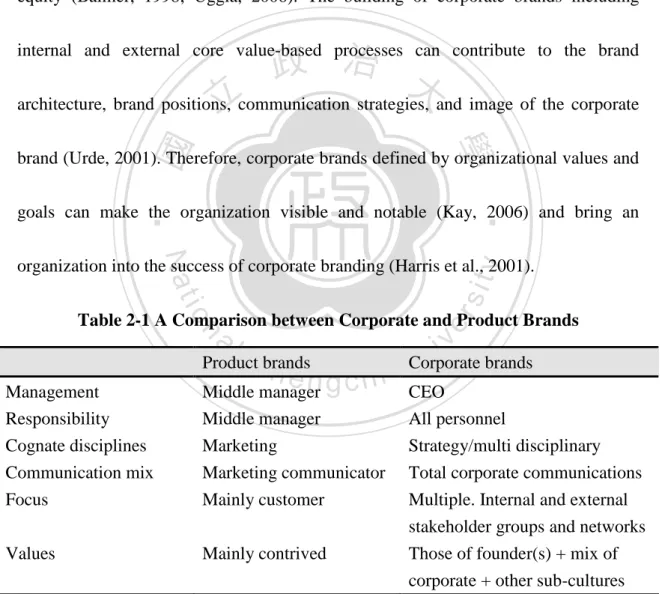
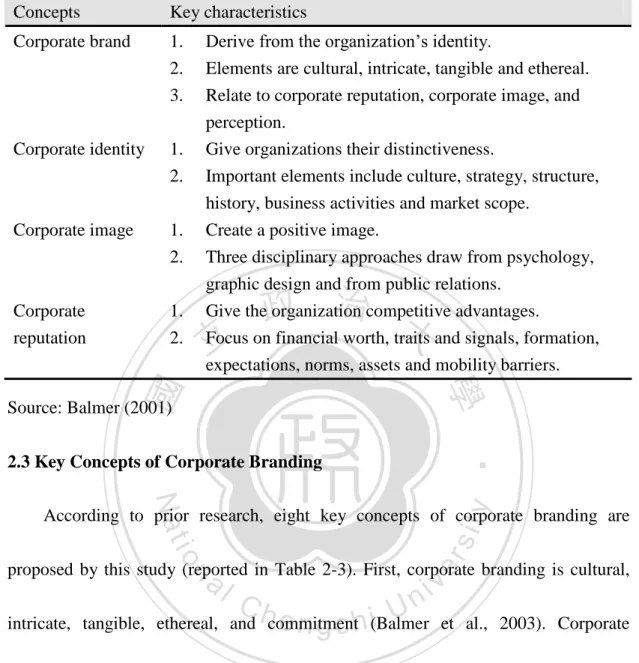
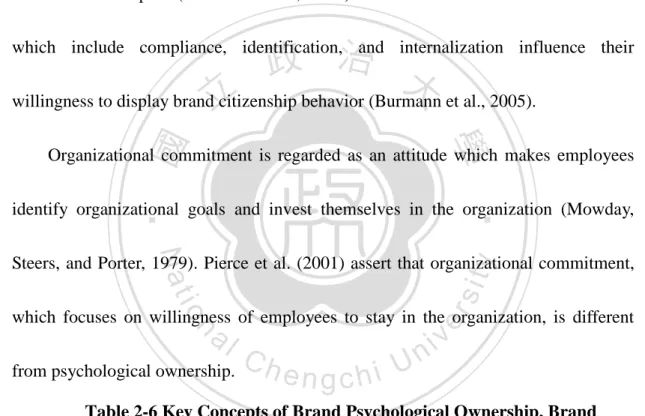
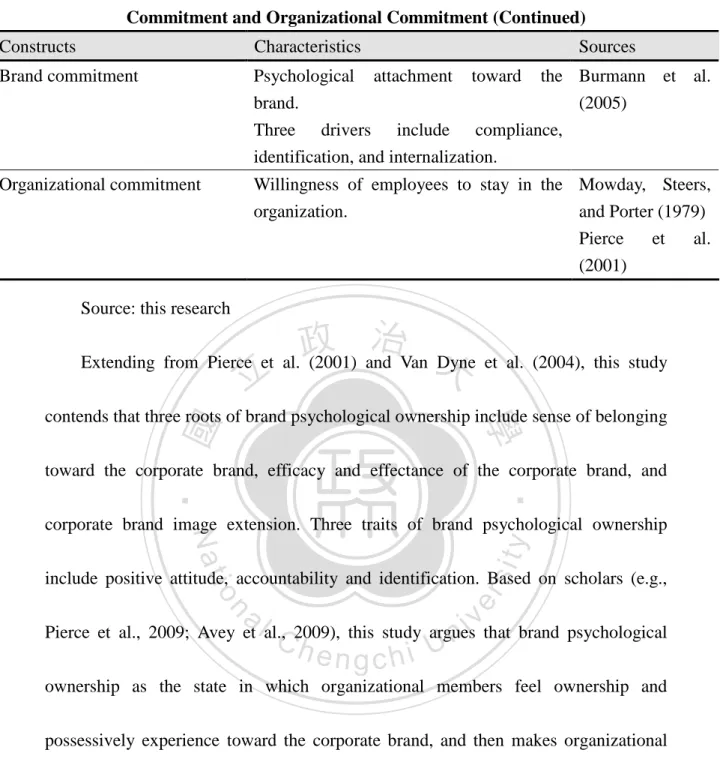
Outline
相關文件
The four e/g-teaching profiles identified in this study are outlined as follows: parsimony (low e-teaching and medium, below- average g-teaching), conservation (low e-teaching and
香港大學佛學研究中心 客座助理教授.. 妬不男 ﹕男根似無,見他行婬,因生 妬心,遂感有根
基於 TWSE 與 OTC 公司之特性,本研究推論前者相對於後者採取更穩定之股利政 策 (Leary and Michaely, 2011; Michaely and
“ Consumer choice behavior in online and traditional supermarkets: the effects of brand name, price, and other search attributes”, International Journal of Research in Marketing,
本研究將針對 TFT-LCD 產業研發單位主管與研發人員進行 探討,並就主管於研發人員對職能重視程度作差異性分析。因此
and Kasper, H.D.P., “The impact of Satisfaction on Brand Loyalty: Urging on Classifying Satisfaction and Brand Loyalty,” Journal of Consumer Satisfaction, Dissatisfaction
在與 WINS 有關的研究之中,除了研發感測器硬體這個領域之外,其它的領域均需要
本研究採用的方法是將階層式與非階層式集群法結合。第一步先運用
